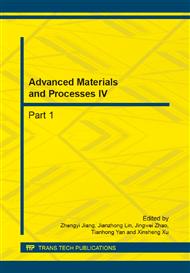[1]
Zitian Fan, Wenming Jiang. Development Trend and Status of Lost Foam Casting Technology [J] (in Chinese). Foundry, 2012(6): 583~591.
Google Scholar
[2]
Mirbagheri S. M. H., Serajzadeh S, Varahram N, et al. Modeling of foam degradation in lost foam casting process [J]. Materials & Design, 2006, 27(2): 115~124.
DOI: 10.1016/j.matdes.2004.09.018
Google Scholar
[3]
Ohnaka Itsuo, Sugiyama Akira, Konishi Kunihiko, et al. Computer simulation of lost foam process of cast iron [J]. Key Engineering Materials, 2011, 457: 299~304.
DOI: 10.4028/www.scientific.net/kem.457.299
Google Scholar
[4]
Liu Ying, Bakhtyarov Sayavur I, Overfelt Ruel A. Experimental study of EPS decomposition in lost foam casting process [J]. American Society of Mechanical Engineers, Fluids Engineering Division (Publication) FED, 2000, 255: 79~84.
Google Scholar
[5]
Li Fengjun, Shen Houfa, Liu Baicheng. Modeling of mold filling and solidification in lost foam casting [J](in Chinese). Journal Science and Technology, 2003, 19(5): 395~397.
Google Scholar
[6]
Khodai M, Parvin N. Pressure measurement and some observation in lost foam casting [J]. Journal of Materials Processing Technology, 2008, 206(1-3): 1-6.
DOI: 10.1016/j.jmatprotec.2007.11.309
Google Scholar
[7]
Barone M, Caulk D. Analysis of mold filling in lost foam casting of aluminum [J]. International Journal of Metalcasting, 2008, 2(3): 29-43.
DOI: 10.1007/bf03355431
Google Scholar
[8]
Chakherlou T. N., Mahdinia Y. V., Akbari A. Influence of lustrous carbon defects on the fatigue life of ductile iron castings using lost foam process[J]. Materials & Design, 2011, 32(1): 162~169.
DOI: 10.1016/j.matdes.2010.06.015
Google Scholar
[9]
Naro Rod L. Battling the elusive lustrous carbon defect [J]. Modern Casting, 2003, 93(5): 32~35.
Google Scholar
[10]
Laifa Wu, Hongchao Sun, Zhengzheng Xu. Analysis and solution of carbon inclusions defect of ductile iron wheel in lost foam casting [J] (in Chinese). Special Casting & Nonferrous Alloys, 2003, 23(6): 53~54.
Google Scholar
[11]
Sun W. L., Littleton H.E., Bates C. E. Formation mechanism of gas cavity defects in lost foam iron casting [J]. International Journal of Cast Metals Research, 2003, 16(6): 549~553.
DOI: 10.1080/13640461.2003.11819634
Google Scholar
[12]
Hejazi M-Mehdi, Divandari M, Taghaddos E. Effect of copper insert on the microstructure of gray iron produced via lost foam casting [J]. Materials & Design, 2009, 30(4): 1085~1092.
DOI: 10.1016/j.matdes.2008.06.032
Google Scholar
[13]
Wenhao He, Shengping Ye, Xiaohong Han, et al. Ductile iron lost foam casting technology development and production application about medium and small sized castings in China [J]. 69th World Foundry Congress, Hangzhou, China, 2010, 3: 978~982.
Google Scholar
[14]
Chisamera M, Riposan I, Stan S, Stefan E, Costache C. Thermal analysis control of in-mould and ladle inoculated grey cast irons [J]. China Foundry. 2009, 6(2): 145–51.
DOI: 10.1007/s41230-020-9147-x
Google Scholar
[15]
Dioszegi A, Svensson IL. On the problems of thermal analysis of solidification [J]. Materials Science and Engineering A, 2005, 413–414: 474–9.
Google Scholar
[16]
Dioszegi A, Hattel J. Inverse thermal analysis method to study solidification in cast iron [J]. International Journal of Cast Metals Research, 2004, 17(5): 311–8.
DOI: 10.1179/136404604225020687
Google Scholar


